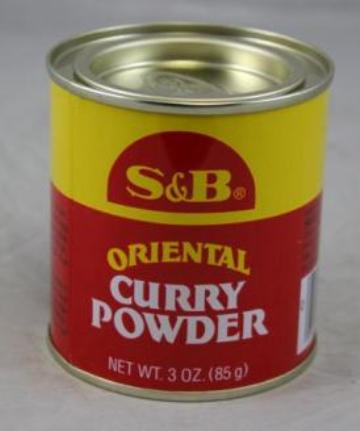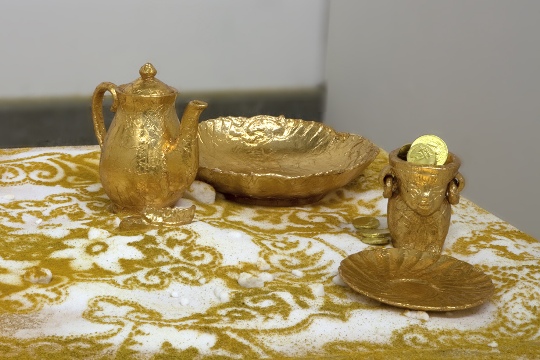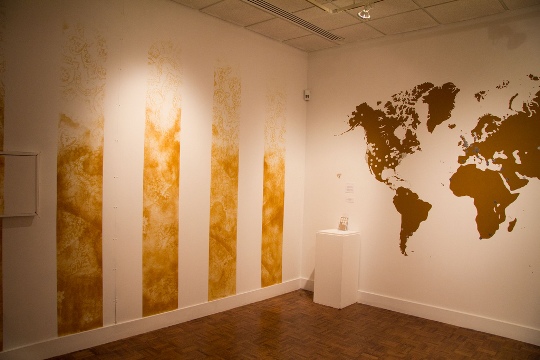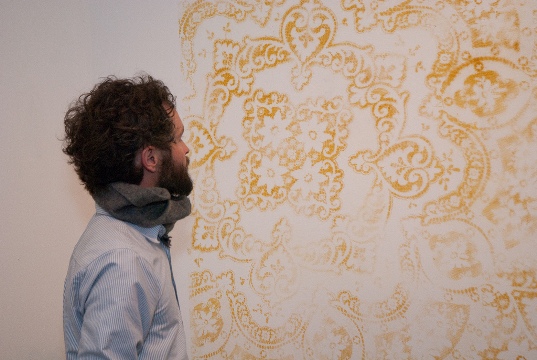
S and B Oriental Curry Powder is the most popular curry powder in Japan and also artist Sita Bhaumik's initials; she took it as a sign. Photo: Onlyfromhawaii.com.
New relationships are often built over food. We sit down to share a bowl of soup together and rise knowing each other better than before. But food’s not just a harbinger of the new; it’s also a pathway to the past. All ingredients, from chai tea to mayonnaise, arrive in our cups and on our plates laden with history. Food carries stories of colonialism and cultural exchange, migrations and regional settlement, and can often invoke overlooked or underrepresented legacies.
Oakland, California, artist Sita Bhaumik describes her practice as “the lovechild of Edward Said and Willy Wonka.” Favoring ingredients like ice cream and curry powder, Bhaumik uses food not only to build connections in the present, but also to investigate social exchanges of the past.
Victoria Gannon: I see a lot of artists using food as a gesture of goodwill, as something that brings people together, but your work highlights differences, rather than commonalities, investigating food as a material rather than simply a means to an end.
Sita Bhaumik: I definitely use the appeal of food and the pleasure of food in my work, but I’m also really aware of how polarizing food can be.

Sita K. Bhaumik, Studio shot of "Curry Table Installation" (close-up), curry, sugar, gold foil from chocolate wrappers, home objects. 2011. Photo: Sita Bhaumik.
Researching curry, I ran into all these complaints online about the smell. I’d never really thought that you could be racist with your other senses, other than your eyes—it’s always reduced to a visual problem—but all of these comments online were talking about, “My neighbor’s house smells like curry; what do I do?” One said, “Help, my neighbor’s house smells like curry,” and the answer was, “Call the INS.” There were other ones that were like, “Oh I bought this couch from this lovely Indian couple, but it smells like curry,” which is a more underhanded way to talk about it.
Before curry, I was obsessed with MSG. A Japanese scientist invented it; he was trying to create something that would make kids want to eat their vegetables. It started in Japan, traveled around, and got to China and other Asian countries. The West discovered it during WWII. American soldiers were leaving their rations behind and picking up Japanese rations because they tasted better. After WWII, the quartermaster general invited corporations to a symposium where he presented this newfound ingredient; Campbell’s was there, and to this day, they use tons of it.
VG: When I’ve heard you talk about curry and how it was adopted by various cultures, I remember you said something about a war.
SB: There’s always something to do with war.
VG: Right—because in wars, countries clash and kill each other, but they also absorb parts of each other’s cultures. I was reading this book called We Are What We Eat (Gabaccia, 1998) and in it, the author talks about slavery and Southern foods. Slave owners and enslaved people were supposedly discrete groups, but if you look at how they ate, you see the places where the two groups intersected and influenced each other. Food becomes evidence of relationships you wouldn’t expect.

Sita Bhaumik, "The Curry Institute," an exhibition at the Sheehan Gallery at Whitman College. 2011. Photo: Flickr.com/photos/mhzmaster/5386815242/.
SB: Curry is a British invention that came about after the colonization of India. It became so popular in England that they started serving it once a week on ships in the military; that ship ended up in Japan, and the myth is that there was this young boy who boarded the ship and ate curry, and it was so delicious, he went and shared it with Japan. That’s the reason Japanese curry is beef-based, which you wouldn’t find in India; the Japanese got their recipe from the British. The curry you find in England is based on the Indian spices, but with a French cooking technique, with added thickeners.
What’s really interesting is that the chili is American; it didn’t get to India until the 1600s, so it wasn’t until the discovery of the New World that you could actually get spicy curry. Which is kind of mind-blowing, because when you ask people about curry, the first question is, How spicy is it?
VG: I’ve seen images of your work where curry powder is applied to walls and furniture. Can you talk about why you choose those forms?

Sita Bhaumik, "To Curry Favor," installation view of solo show at 18 Reasons. 2010. Photo: Flickr.com/photos/vkdir.
SB: In those pieces, I’m really referencing home and hospitality and how we welcome people into our home, all of the posturing we do and the fancy things we collect, but also the genuine sentiment behind the artifice. I think the aroma of it is really interesting, because you don’t have to tell people what to do with it. It’s just sort of present and it draws people in, and then it becomes part of this experience of place.
VG: Is smell the primary way people interact with the pieces?
SB: I’m really invested in the visual, but it’s been really interesting to grapple with this invisible medium; I’m used to dealing with things materially, but now I’m working with this medium that can be invisible. You can use it as liquid, and you can fill a room with it, and it can inhabit a room. Smell can fill a space without having a visible presence.
VG: Race isn’t material, either; it’s this immaterial thing that you can’t quite pinpoint or locate.
SB: It’s shifting, too.
VG: I wonder if smell is particularly suited to representing that.
SB: Sanjit Sethi did a piece (Kuni Wada Bakery Remembrance, 2008) where he interviewed people in Memphis about the disappearance and imprisonment of this one Japanese-American family around WWII; everyone said they remembered the smell of freshly fried donuts. He ended up creating the smell of cinnamon sugar donuts in his piece.

Sanjit Sethi, "Kuni Wada Bakery Remembrance," 2008; installation view. Courtesy the artist.
VG: I like smell as being an intimation of absence. You can’t touch it or see it; it’s this invisible presence, like a ghost.
There’s so much talk in the Bay Area about food—we have Michael Pollan and Alice Waters—and discussions about localism seem to dominate the discourse. Is there anything that you feel isn’t being said?
SB: I think that one of the things is really seductive to all of us is this idea of authenticity that’s really problematic. For example, we all want to discover this hole in the wall, and I feel like that totally parallels this conquistador mentality; we want the restaurant to be just grungy enough to be real, but not so grungy … And then people talk about it as this isn’t the place anymore, because there are just too many of us. You’ve got to discover a new land.




